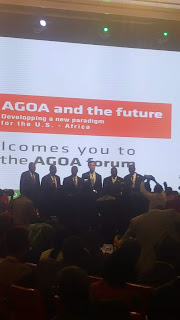 |
| Africa Map (open source) |
By way of background, the AFCTA was first signed on March 21, 2018, in Kigali Rwanda, with an initial 22 countries signing up (https://au.int › cfta › about). By July 2019, all 54 African nations had signed -- making the Continent potentially a $USD 2.4 trillion trading block. The rather quick turn-around on the AFCTA being signed by 54 nations in slightly over a year left many traditional doubters who touted the mantra that the "AFCTA will never be fully ratified," and again left flying in the wind -- having based their sentiments on the region's history of having previous draft agreements languished for decades. .
 |
| 2019 AGOA Forum. Hosted by Ivorian President Ouattara |
-- Policy formulation, including harmonizing trade tariffs,
-- Infrastructure development, including the building of the Ghana HQ, and;
-- Technical assistance, including on how to run a large trade organization.
However these three areas must be managed through the vision and leadership of Africa nations. Furthermore, there are still underlying questions as to how Africa's leading partners (China, the U.S., Europe, and possibly a post-Brexit UK), are going to engage with the AFCTA, given the number of existing bilateral trade arrangements, and those that are being courted for the future. Reports also are that China has already agreed to build the Ghana-based HQ.
As for the U.S., at the recent August 2019 US-Africa African Growth and Opportunity Act (AGOA) Forum, in Abidjan, West Africa (which FEEEDS attended) the importance of the AFCTA was raised further. Of note, AGOA is the only U.S. annual meeting with African Trade Ministers, but also thus far, the only large-scale yearly event the U.S. holds with a region that will eventually become the most populous Continent in the world. (https://agoa.info; https://www.trade.gov).
At the AGOA Forum, AFCTA was the marquee policy noted by every African trade minister at every roundtable and every plenary session. The message to the U.S. and all partners in attendance is "there is no day light among us," on how Africa's future trade relationships will and shall proceed, and "efforts that are not inline with this direction will be concerning."
In reading the tea leaves then, we all need to do the utmost to help the AFCTA succeed. To do so is in our interest as we in America look for sustainable trading partners, and markets for our goods and services. Remember the three areas I mentioned above -- policy formulation, infrastructure development, and technical assistance -- as well as having an emphasis on SMEs. The U.S. can provide value added in all these areas and we should because we do these things very well. These are our strengths and we should be at the table with our African partners as they set out to put in place and operationalize one of the most important trade institutions since the creation of the World Trade Organization (WTO) on January 1, 1995. (https://www.wto.org).
 |
| Country Flags from 2019 AGOA Forum participants |
